U.S. Department of Transportation
Federal Highway Administration
1200 New Jersey Avenue, SE
Washington, DC 20590
202-366-4000
California, Maryland, Montana, New York, North Dakota and Utah have been named recipients of 2007 Highways for LIFE incentive funding.
That brings to 15 the number of states receiving Federal Highway Administration grants to build projects using innovations that will cut construction congestion while enhancing safety, quality and user satisfaction. Earlier, FHWA announced that Arizona, Georgia, Maine, Missouri, Oregon and Virginia would receive 2007 grants. In 2006, Iowa, Minnesota and South Carolina won grants.
The California Department of Transportation will use its grant to rehabilitate a section of Interstate 15 in San Bernardino and Riverside Counties with a precast concrete pavement panel system.
Using the system will enable the contractor to replace pavement sections quickly during nighttime and weekend lane closures, reducing driver impacts by an estimated 70 percent over traditional construction methods. Analytical software will optimize the construction schedule and traffic control plan to reduce construction congestion.
The project team is planning outreach techniques-including public meetings, a project website and changeable message signs-to keep the public informed about construction progress.
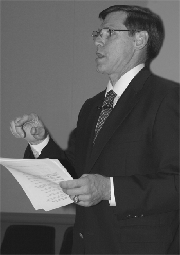
FHWA Administrator J. Richard Capka announced the latest projects receiving Highways for LIFE grants at the AASHTO Annual Meeting in Milwaukee, Wis.
Credit Wisconsin Department of Transporation
Full-road closures and precast, prestressed concrete superstructures will accelerate construction when the Maryland State Highway Administration replaces bridges on Maryland 28 in Frederick County and Maryland 725 in Prince George's County. Using these innovations is expected to cut construction time from a year to 60 days.
The agency plans to involve the public during planning and construction through meetings and use mailings and roadway signs to keep citizens informed of project progress.
The Montana DOT project will use innovative techniques to retrofit liners into cross culverts along a section of US 12 in Powell and Lewis and Clark Counties. Crews will install drilled-in smooth plastic liners or cured-in-place polymer compound liners in existing culverts instead of excavating and replacing them.
Using this practice will allow crews to close a single lane of the four-lane highway for one day to work on each culvert, while the traditional culvert replacement process requires closing half of the highway at a time for a total of four days. That will reduce lane closures by 75 percent.
The New York State DOT will replace approach slabs on 15 bridges on Interstate 88 in Delaware and Schoharie Counties. Using precast, prestressed concrete slabs rather than cast-in-place concrete will enable crews to work at night, eliminating the need for daytime work zones and lane closures. To close lanes, crews will use movable traffic barriers, which can be positioned by machine in a fraction of the time it takes to move traditional barriers one by one by truck-mounted crane.
Using precast concrete and movable barriers is expected to reduce construction time by 75 percent and provide motorists with work zone-free daytime travel while the project is underway and a better ride quality when it's finished. Because of their durability, the precast slabs are expected to provide long, maintenance-free service.
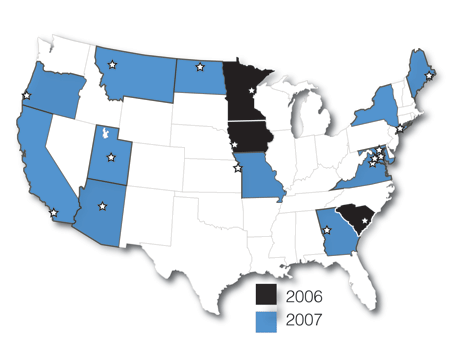
Map of the United States showing 2006 and 2007 award states.
Improving ride quality, reducing noise, enhancing safety and cutting maintenance costs are goals for the North Dakota DOT's rehabilitation of a section of US 2 from Berwick to Rugby. The agency will use an innovative process known as whitetopping, or placing a concrete overlay over existing asphalt pavement, instead of replacing the asphalt.
The agency will close two lanes of the four-lane road at a time to enable the contractor to finish the job faster. Combined, the use of whitetopping and lane closures will cut construction time an estimated 40 percent over traditional methods.
Prefabrication will speed up work on the Utah DOT's replacement of a bridge on SR 266 over I-215. The new superstructure will be constructed off-site, and the new substructure will be built under the existing bridge while it remains in service.
Once the new substructure is complete, the existing structure will be removed and the new superstructure will be moved into place with a self-propelled modular transporter. Using prefabrication will reduce construction impact on motorists by 80 percent and result in a smoother, quieter and longer-lasting bridge.
For more information, contact Mary Huie at (202) 366-3039 or mary.huie@dot.gov or visit www.fhwa.dot.gov/hfl.

Missouri DOT Director Pete Rahn
Did you start your state DOT CEO jobs with specific goals in mind?
My stint in New Mexico was really on-the-job training. From a management standpoint, I knew our roads were in poor condition, I knew that service to the public was not that good, but I didn't have specifics in mind. As a team, we jumped on it quickly, but the day I started I didn't have a set of objectives.
With MoDOT I knew what I was looking for, and from my experience in New Mexico I believed I knew how to get there. You don't really know when you start your second round if what you learned the first time is applicable to a new department in a new state. Now, three years into it, I can say yes. Issues, people, all those sorts of things are very similar, and what worked in New Mexico is working very well in Missouri.
How do you set goals?
We do it as a team. It starts with a conversation with the 45 members of senior management. We spend a full morning discussing what truly is our mission as an organization. Then I focus on the tangible results that I believe the public expects from us if we are delivering on our mission.
In our case we ended up with 18 tangible results, such as smooth roads, uninterrupted traffic flow and clean roadside accommodations. I frequently say that if our efforts do not directly impact one of those results we shouldn't be doing it. From those 18 results, we came up with performance measures to indicate progress.
How do you use performance measures to assess progress?
We have 108 performance measures right now. It is a very fluid process. If a performance measure has served its purpose, we jettison it. Maybe we replace it and maybe not. Maybe there's no longer a need for it. We also look at how we can improve the measurements we have so that they're more indicative of performance.
We have a quarterly meeting with about 120 people in the department-those who are responsible for developing the measures as well as those who impact the measurement. We spend a whole day going over the measures. We talk about every single one. What is the most recent measure? Are we headed in the right direction? If not, what do we have to do to change that?
The document that we produce from this, called the Tracker, is distributed to members of the legislature, the governor, the Highways and Transportation Commission and the media. It's available online to anyone who wants to look at it. It's got warts and all. Frankly, if we're not showing poor performance in some areas, then I'd say it's probably not a true picture because we can't do everything perfectly-although that's my goal.
How do you get employee buy-in?
I find that the challenge for employees, especially with a new CEO coming into the organization, is how to decipher between the management philosophy that's the flavor of the day and what's going to be used to actually manage the organization. Frankly, you can only demonstrate that by following through.
Because I'm such a believer in this mission of tangible results focus along with performance measures, certainly by now they understand that this is critical and this is how MoDOT is going to operate. They've been able to see the positive effects of utilizing this system. For the most part, we've gotten significant buy-in.
How do you involve contractors and suppliers?
We're progressing quite well with performance-based contracts rather than method and means. We also involve our contracting community in a process we call PIE meetings, or Process for Innovation and Efficiency. We pick topics that have been presented to us by industry as areas in which we can improve.
We then invite people with specific knowledge of the activity and spend the day dissecting it. The first part of the day is spent talking about what the problems are and the latter part is spent talking about specific actions we need to take to address those problems. We have a process in which we charge employees as well as volunteers from the PIE meeting to implement these actions.
How do you share agency goals with the public?
We have an extremely active Community Relations Division that communicates with a broad range of people. We have an electronic newsletter called the Express Lane that we send out by e-mail. Part of our Tracker is number of media contacts. Every year we survey the people we're sending our news releases to and ask them whether they find them timely, accurate and newsworthy. We also contract for a survey of 3,000 Missourians. We have gone from 67 percent satisfaction with MoDOT in 2004 to 79 percent today.
How do you encourage innovation?
We have several programs designed to encourage innovation. One is a program called “Solutions at Work,” in which we provide a cash incentive to an employee who submits an innovative process or technology or tool to do our jobs better, faster, cheaper. We get about 35 or 40 submissions a quarter, and we're identifying between 9 and 16 percent as being truly innovative.
In return for the cash award, the employee takes on the task of sharing this as a best practice. They travel to the districts to explain how they do it and how it works. After they're done, our Organizational Results Unit goes back to the districts and says, “Did you implement this best practice? If you didn't, give us specific reasons why it didn't apply.” They're pretty tough. They won't accept very many excuses.
What have you learned about leading change?
You don't have to know the answer before you begin. Some of the most innovative things I've been involved with were results that I could never have anticipated when we started.
You also don't need 100 percent of your organization to be on board with you to change culture and behavior. My estimation is that you need 20 to 30 percent. Fifty percent will have an approach that is basically “I'll do what I'm told,” so they'll follow. And then you've got this remaining 20 or so percent who have to decide to get on board or find an organization in which they're more comfortable. That's basically how you drive change
To view Tracker, go to www.modot.org/about/general_info/Tracker.htm. For Express Lane, visit www.modot.org/TeamTransportation.

Photograph showing construction workers lowering a PCC slab into place.
Case in point: The chance to earn $5 million in incentives pushed a contractor to finish repairs on a collapsed ramp in Oakland, Calif., in 17 days rather than the state's estimate of 50 days.
The California Department of Transportation estimated that repairs to a section of the MacArthur Maze, damaged when a gasoline tanker crashed and burned, would cost $5.2 million. For every day short of the June 26, 2007, deadline, the agency offered a $200,000 bonus, up to $5 million total.
The highest bid was $6.4 million. Construction firm C.C. Myers of Rancho Cordova, which won the job with the low bid of $867,075, had a plan to get the job done fast enough to earn the bonus.
Crews were on the job less than an hour after the contract was signed. Working 24 hours a day in 12-hour shifts, they placed a 55.5-foot (16.9-meter) bent cap and 12 steel girders before pouring the concrete road deck.
“Thanks to hard, around-the-clock work of Caltrans and C.C. Myers, our local partners and businesses, Bay Area motorists can once again travel through this busy interchange,” California Gov. Arnold Schwarzenegger said in announcing the reopening of the ramp the Friday before the Memorial Day weekend.
For more information on the project, visit www.dot.ca.gov/dist4/mazedamage/.
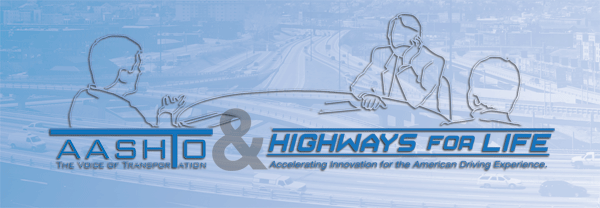
Illustration depicting a group working together with a road in the background. AASHTO and Highways for LIFE logo's included.
The purpose of TIG is to find and champion the implementation of select ready-to-use technologies, products or processes that are likely to yield significant economic or qualitative benefits to users. The Federal Highway Administration created the Highways for LIFE program to spur development of Long-lasting highways using Innovative technologies and practices to accomplish Fast construction of Efficient and safe pavements and bridges.
“Clearly, both programs have the same goal, and both groups work with the same stakeholders-the state transportation departments,” said Byron Lord, Highways for LIFE team leader.
As the two groups find key technologies that both wish to promote, HfL and TIG will work together “with both financial and people resources,” Lord said. Toward that end, the two groups will communicate through meetings and other channels.
The first technology the two groups have identified for cooperation is modular pavements-precast concrete panels for highway construction. Such panels might be, say, 12 feet (3.6 meters) wide by 10 feet (3.0 meters) long, and can be laid down quickly at night, during off-peak traffic hours. The next morning, the pavement is ready for traffic.
The largest panel ever used measured 10 feet (3.0 meters) by 38 feet (11.5 meters) and was limited in size by transportation and handling requirements.
“Modular pavements are another tool in the toolbox,” said Lord. “They will never completely replace cast-in-place pavement, but in certain conditions, such as busy intersections, they can be a viable alternative.”
The HfL program will sponsor a technical workshop on modular pavements in the coming months. Decision makers from the TIG and FHWA groups will plan and conduct that workshop, Lord said.
So far, Virginia, California and New York have won HfL funding for modular pavement projects, so the workshop probably will be regional in nature, although any interested stakeholder can attend.
For more information on the AASHTO TIG, visit www.aashtotig.org.
The Galvin Project to End Congestion and the Institute of Transportation Engineers are sponsoring an Innovations Prize to identify solutions and technologies that facilitate construction of new roadway capacity, particularly in dense urban areas.
Innovations may involve the use of materials, construction processes, designs or other means of overcoming the challenges of adding capacity. The Galvin Project will support the development of innovations in these areas through research grants of up to $40,000.
Two-page statements of interest are due November 1, 2007. Selected individuals will be invited to submit more detailed proposals. For application information, visit www.reason.org/innovationsprize.
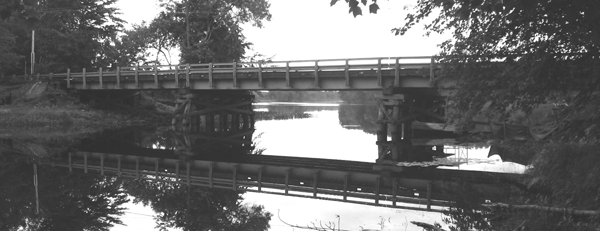
The aging Boom Birch Bridge in Maine was replaced with three precast spans, saving months from the schedule with cast-in-place construction.
To help finance the use of innovations on the bridge projects, the Maine Department of Transportation won grants from the Federal Highway Administration Highways for LIFE program.
At the larger of the two bridges, the three-span Boom Birch Bridge in Old Town, construction required a 14-mile (22.5-kilometer) detour because environmental conditions, namely wetlands on both sides, prohibited the use of an on-site detour. The 69-year-old bridge was structurally deficient and in need of immediate replacement.
Local residents were concerned that construction might extend from summer into the school year, requiring use of the detour for a lengthy time period. Using conventional cast-in-place construction, a typical time frame for removing and replacing this bridge would be about nine months.
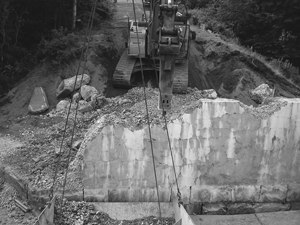
Most state highway agencies now use profilometers to measure pavement smoothness and assure motorists a comfortable ride.
The key innovation on the $1.3 million project was the use of prestressed, precast concrete components that were cast off-site and brought to the bridge ready to erect. The new structure consists of three 47-foot (14.3-meter) prestressed concrete simple spans on precast post-tensioned piers and abutments. Precast caps have never been used for pier bents in Maine before, and rarely for abutments.
There is no cast-in-place deck on the 30-foot-wide (9.1-meter-wide) bridge, which further accelerates construction. All traffic will be supported by precast, prestressed concrete voided slabs that each measure 21 inches (53.3 centimeters) deep by 3 feet (0.9 meter) wide. High-performance waterproofing membrane was placed over the butted slabs, and 3 inches (7.6 centimeters) of bituminous pavement was placed atop the waterproofing membrane.
At the single-span Lamson Bridge in Addison, the 80 percent reduction in construction time resulted primarily from the use of existing abutments and the avoidance of working in Lamson Stream.
Originally the bridge was designed to have pile foundations and precast post-tensioned concrete abutments. But under a value engineering change, the contractor, CPM Constructors, redesigned the bridge to use new spread footing foundations instead of pilings. As a result, construction did not require a cofferdam, which cut months from the construction schedule of the $1.1 million project, said Drozd.
The road closure began July 5 for the bridge, which was scheduled to be complete by Labor Day. Like the Boom Birch Bridge, the 48-foot-long (14.6-meter-long), two-lane Lamson Bridge has precast voided concrete slabs topped by a waterproofing membrane and a 3-inch-thick (7.6-centimeter-thick) bituminous pavement.
Both bridges are expected to improve safety and reduce congestion for the driving public. Through the extensive use of precast concrete components, which are produced in a controlled environment, the bridges will last longer and benefit the driving public by precluding the need for future bridge outages.
For more information, contact Maria Drozd at (207) 622-8350, ext. 108, or maria.drozd@dot.gov.
The Minnesota Department of Transportation used an unprecedented five-month road closure this past summer to cut 60 percent from the timeline to reconstruct a section of Highway 36 in North St. Paul.
Maintaining traffic while crews upgraded the roadway would have subjected drivers to construction delays until fall 2008-an entire year longer.
The Minnesota DOT received Highways for LIFE incentive funding for the project, which involves reconstruction of about 2 miles (3.2 kilometers) of roadway to improve safety and capacity.
The $27 million project includes eliminating several at-grade crossings and building a diamond interchange, three vehicular bridges, a pedestrian bridge to a high school and a tunnel to a popular biking and walking trail.
The full road closure is expected to cut project costs by 15 percent, improve safety for motorists and construction crews, and result in a better quality highway than using traditional staged construction. The completed project is expected to reduce injuries and fatalities on the busy roadway section by 20 percent.
Before starting construction, the Minnesota DOT conducted a survey on two scenarios: closing Highway 36 completely for five months or keeping it open with delays and off-peak closures for two years. Residents and commuters expressed support for both scenarios without indicating a clear preference, while businesses preferred the two-year option.
Among the reasons survey respondents gave for supporting a five-month closure were a preference for a few months of inconvenience rather than two years, lower project costs and increased safety.
The agency held ten public information forums and numerous one-on-one meetings with stakeholders. It developed a strategic communications plan that includes open houses, business workshops, media relations, and provision of real-time traveler information.
Tools the agency is using to keep people informed about the project include e-mail, direct mail, a telephone hotline and a website (www.dot.state.mn.us/metro/). A post-construction survey is planned to assess user satisfaction with the complete closure concept.
In another first for the state, intelligent compaction equipment was used on the project to improve the quality of grading operations. This will potentially lengthen pavement life and reduce the need for traffic-disrupting maintenance in the future.
Computer-controlled intelligent compaction rollers measure and adjust compaction in real time, allowing operators to identify soft spots and correct deficiencies before paving. Crews use lightweight deflectometers to conduct tests on the compacted roadway foundation in a fraction of the time it takes to conduct a traditional sand cone test
In addition to the road closure, the Minnesota DOT chose innovative contracting techniques to further reduce the construction timeline and congestion. They include A+B (cost plus time) bidding and lane rental, under which contractors pay a fixed fee for lane closures during cleanup operations before and after the full road closure.
For more information, contact Terrence Beltz at (651) 291-6116 or terrence.beltz@dot.gov.
Innovator, published by the FHWA Highways for LIFE program, advances implementation of innovative technologies and processes in the highway industry. Its audience is transportation professionals in highway agencies, trade and research groups, academia and the private sector, and the driving public.
Email reprint requests to: Julie.Zirlin@dot.gov